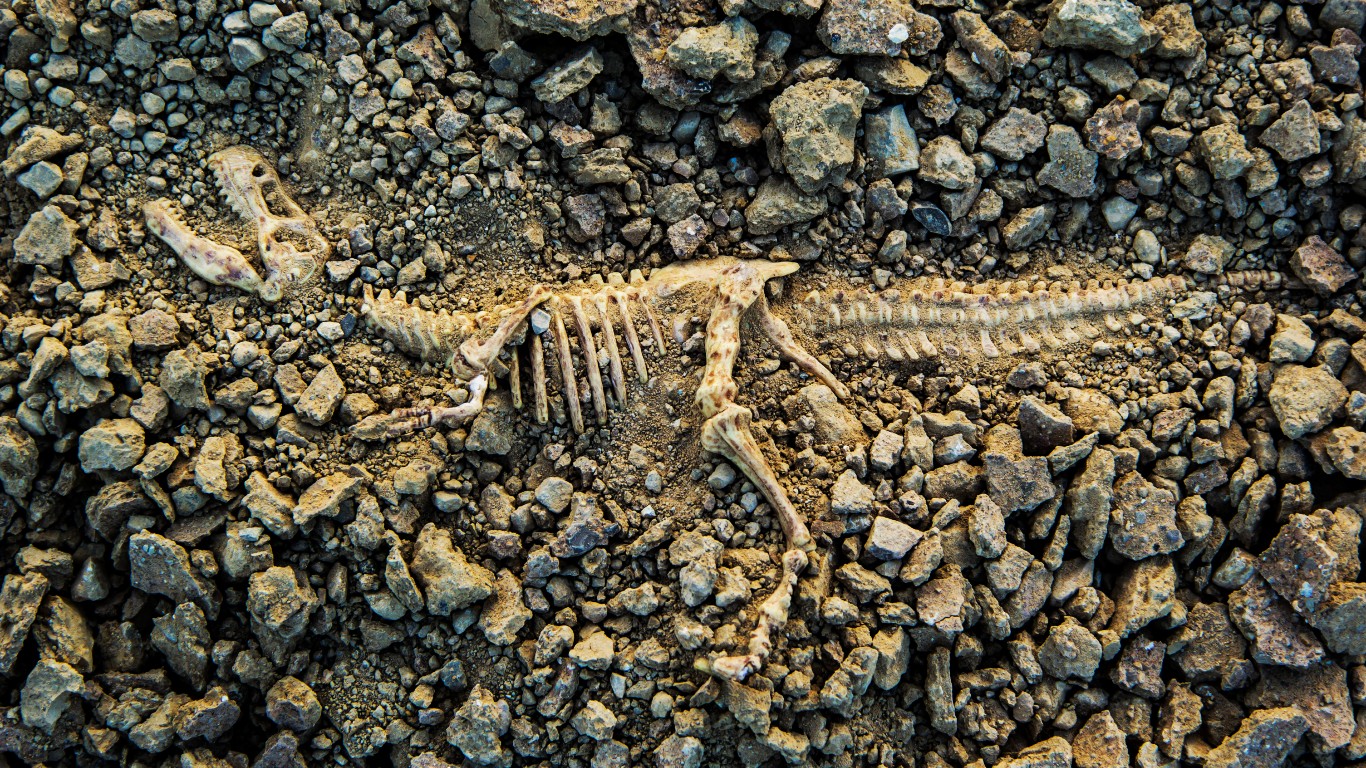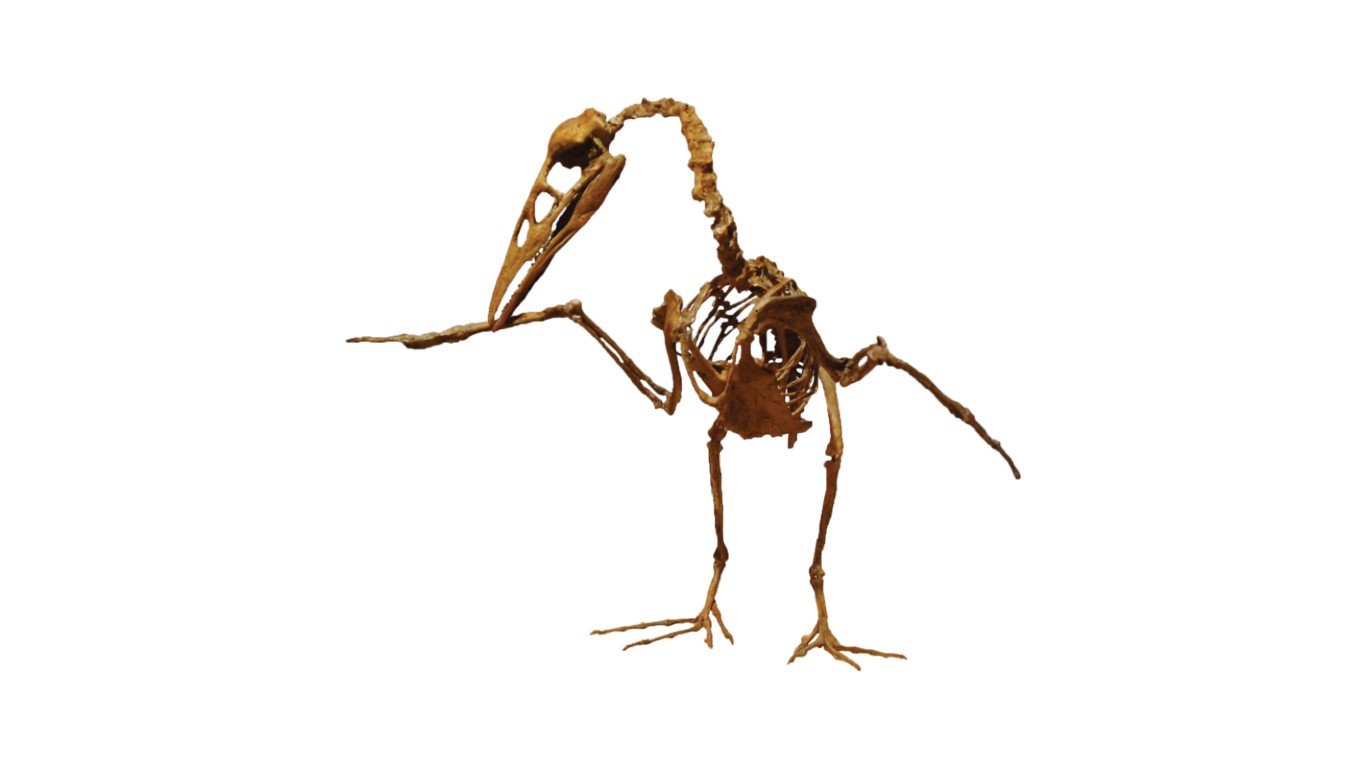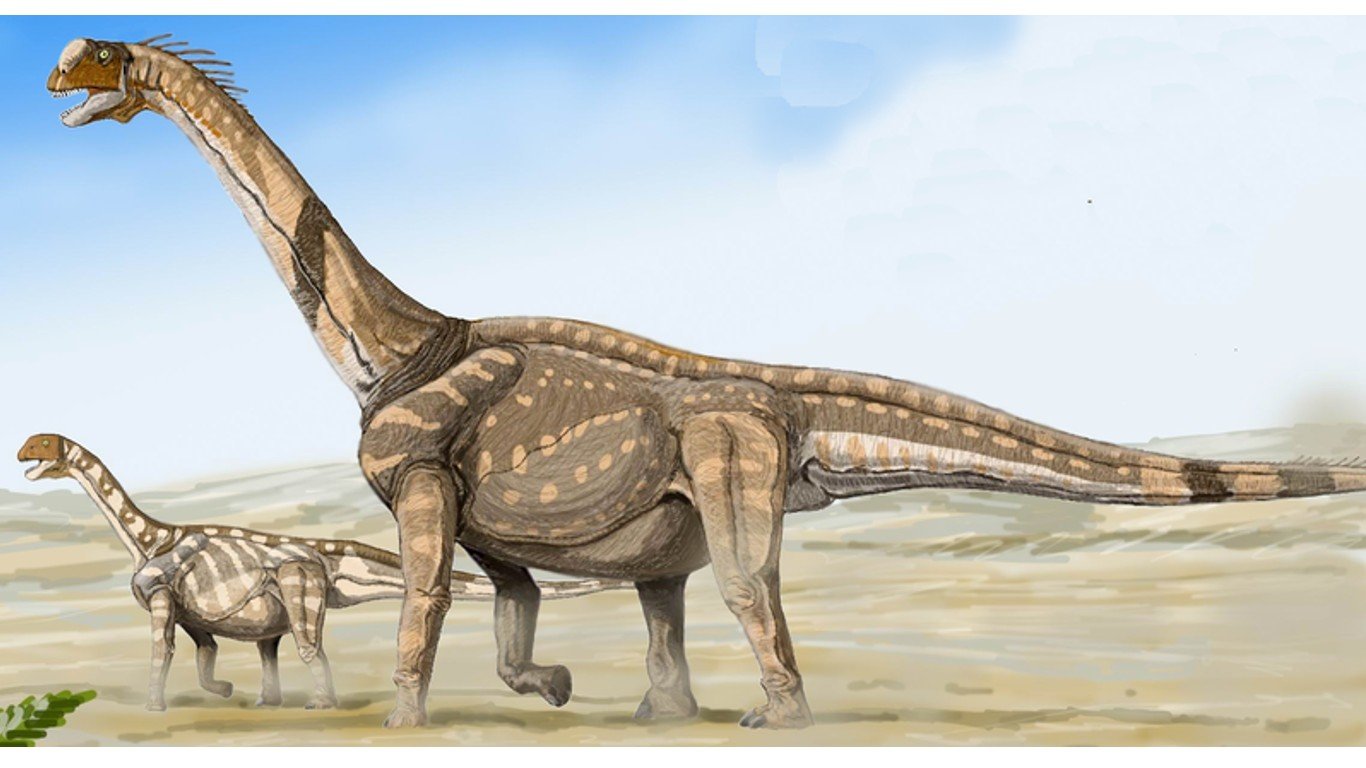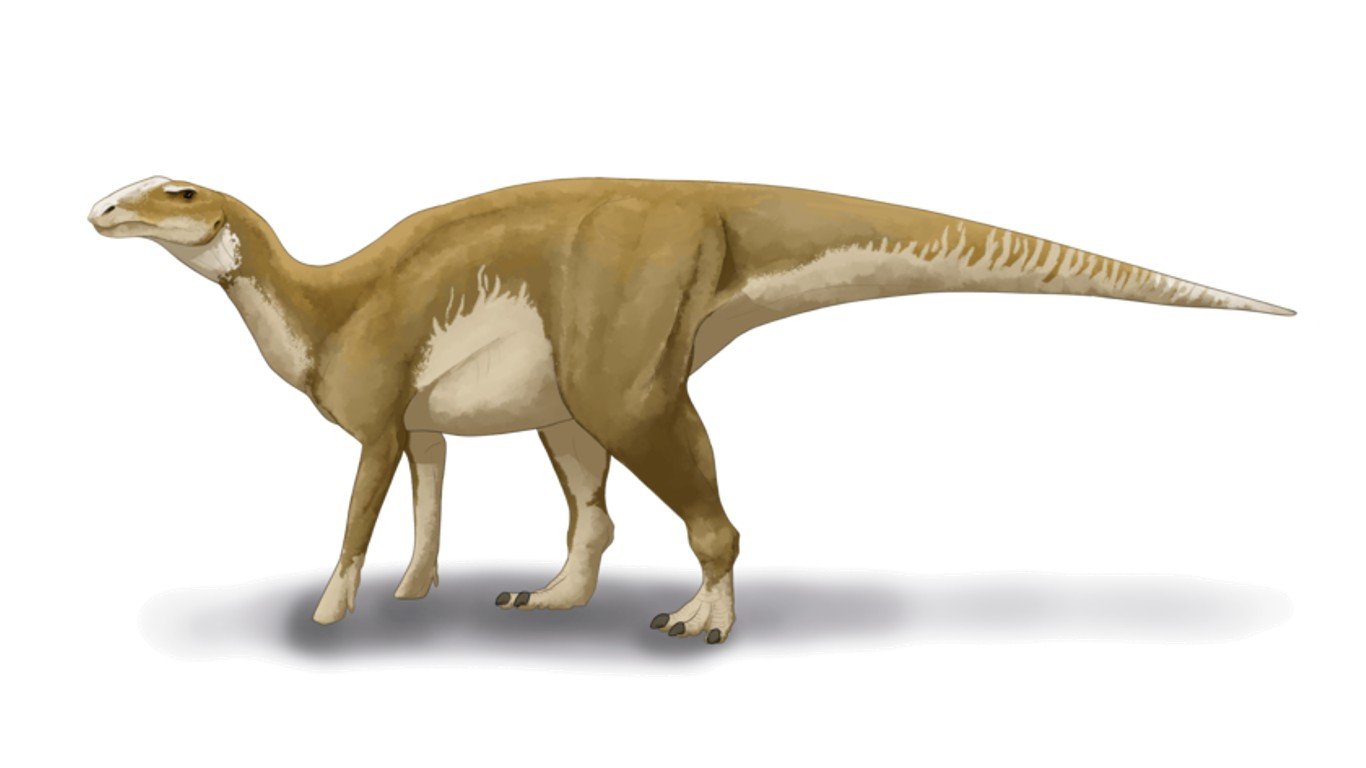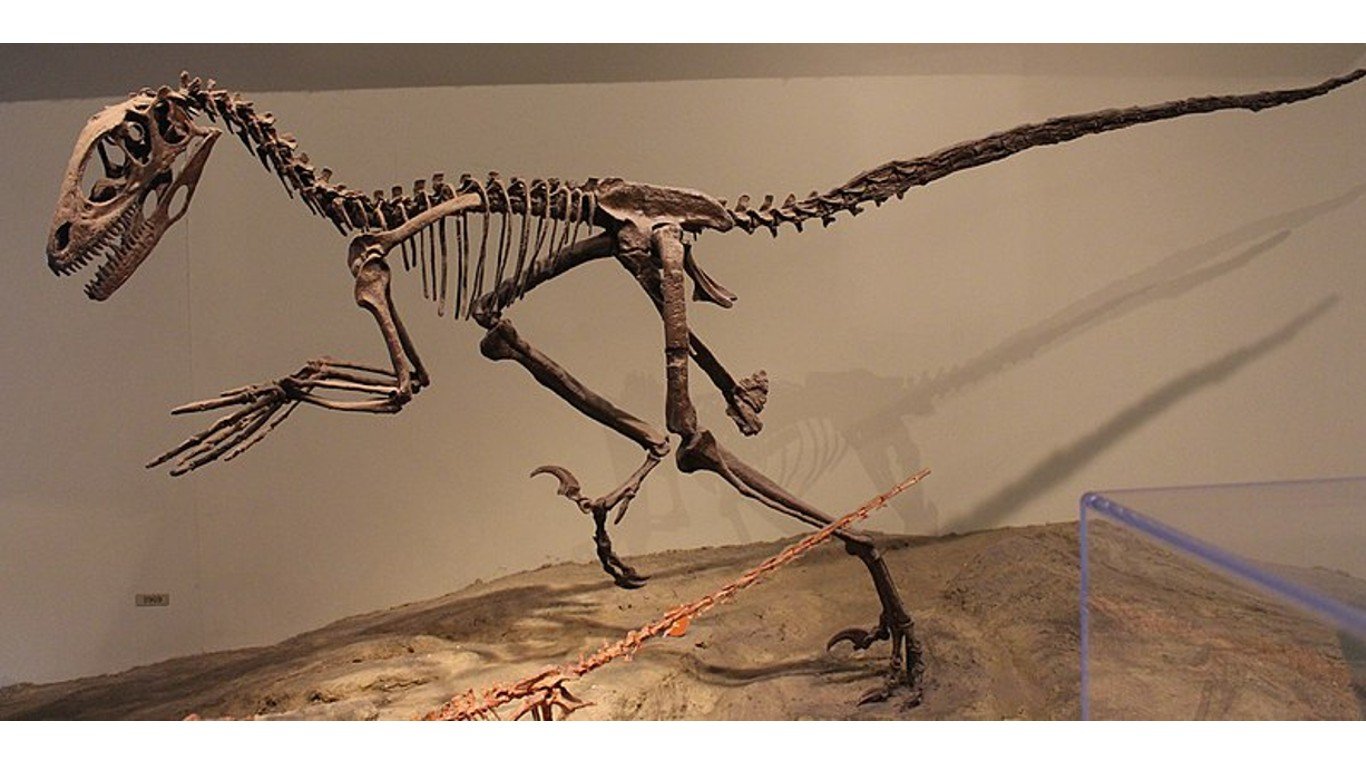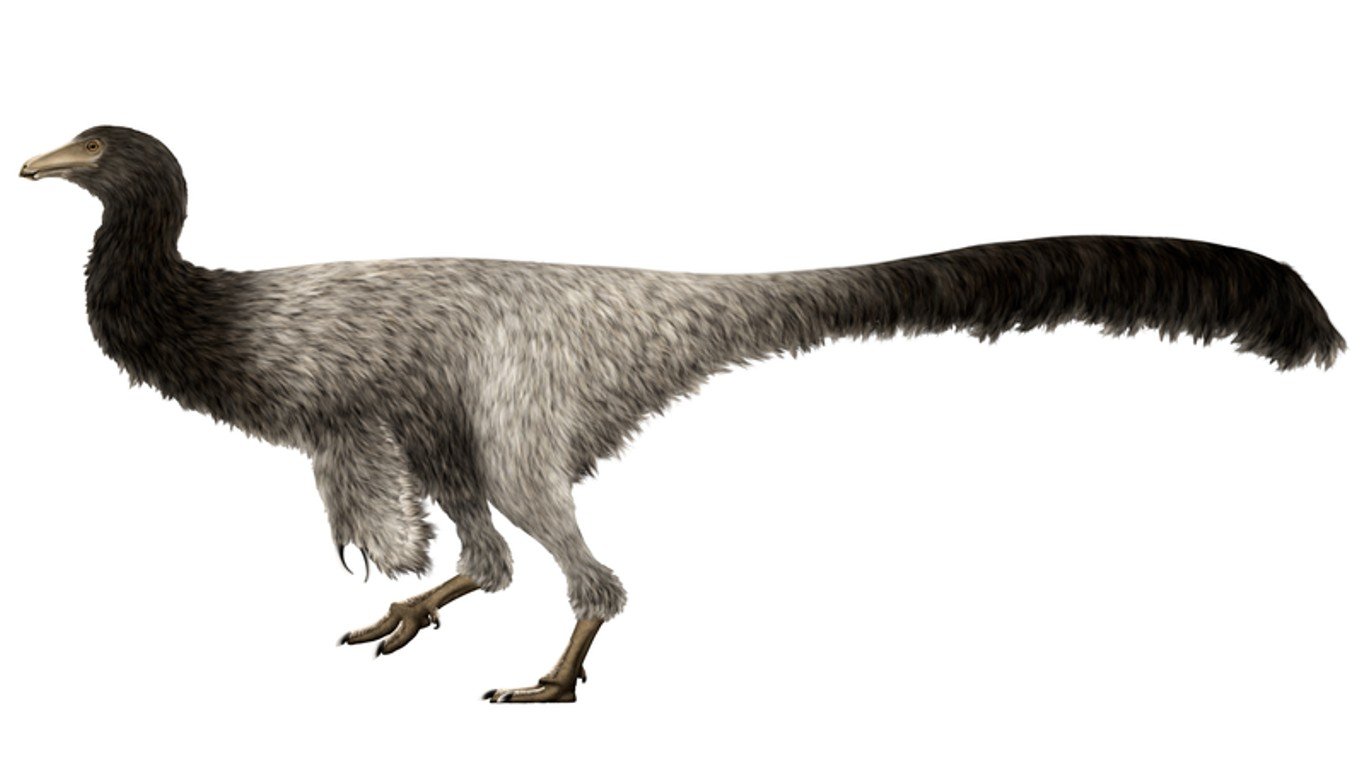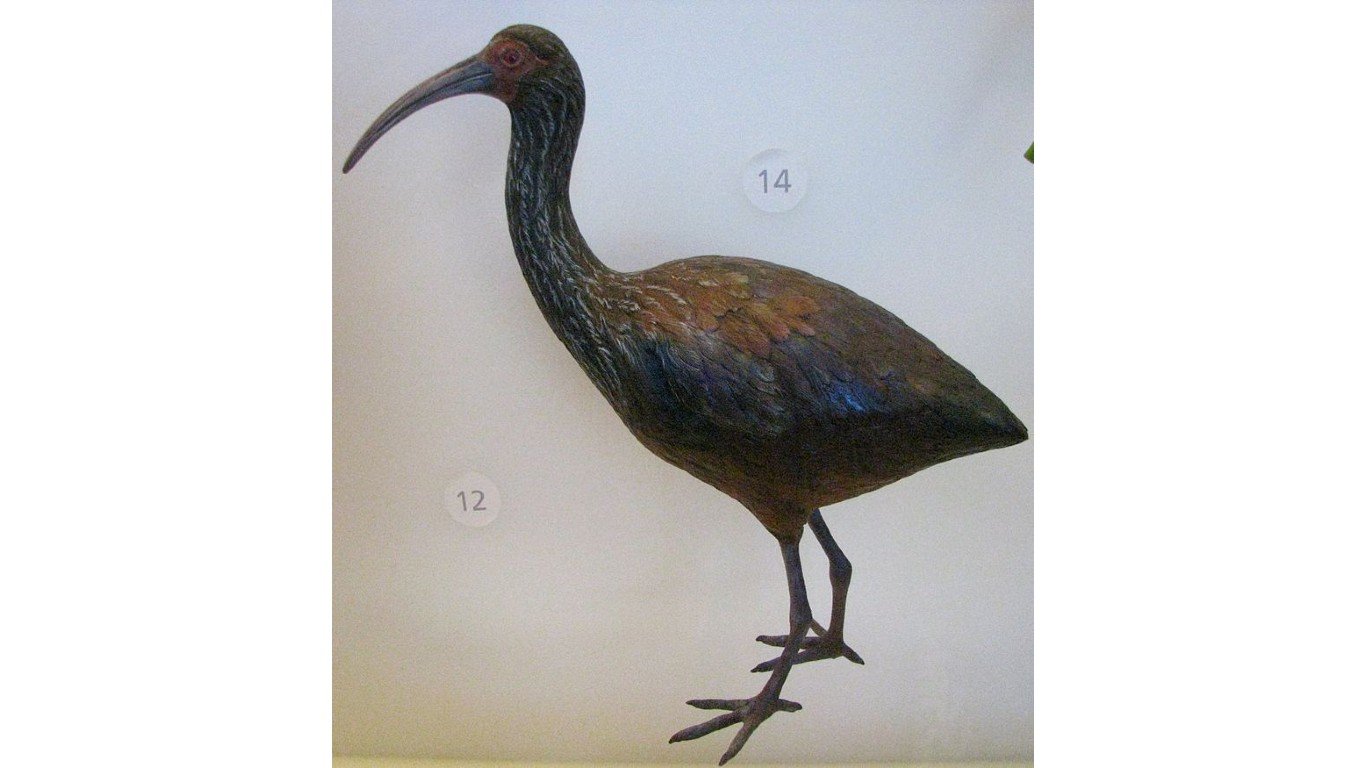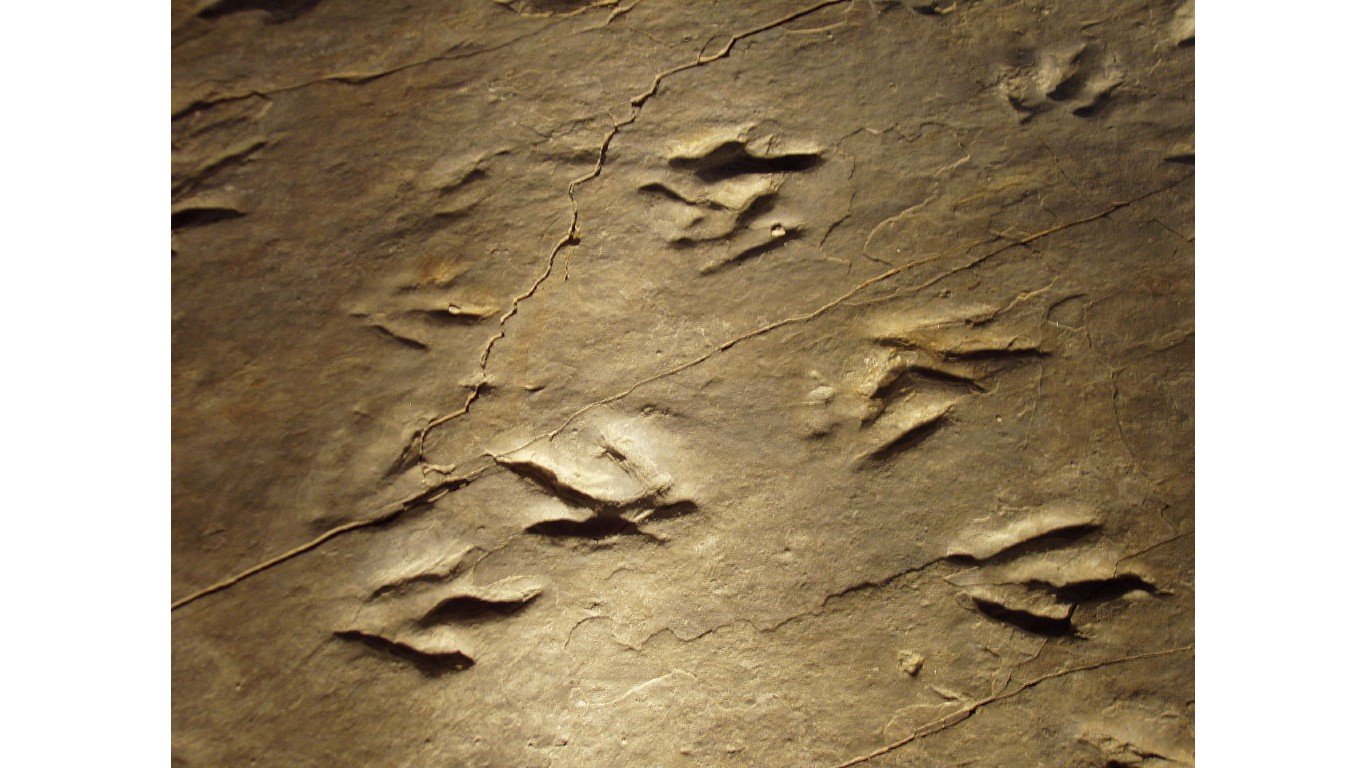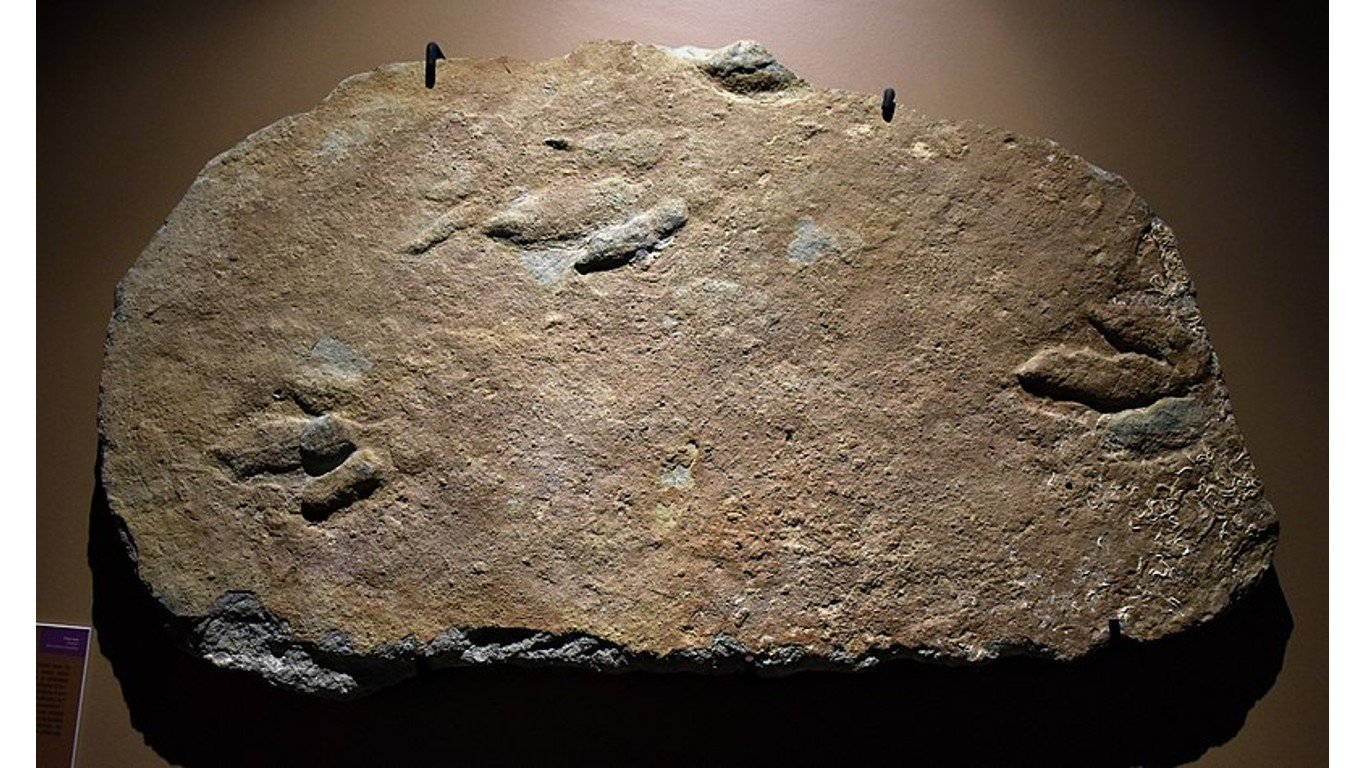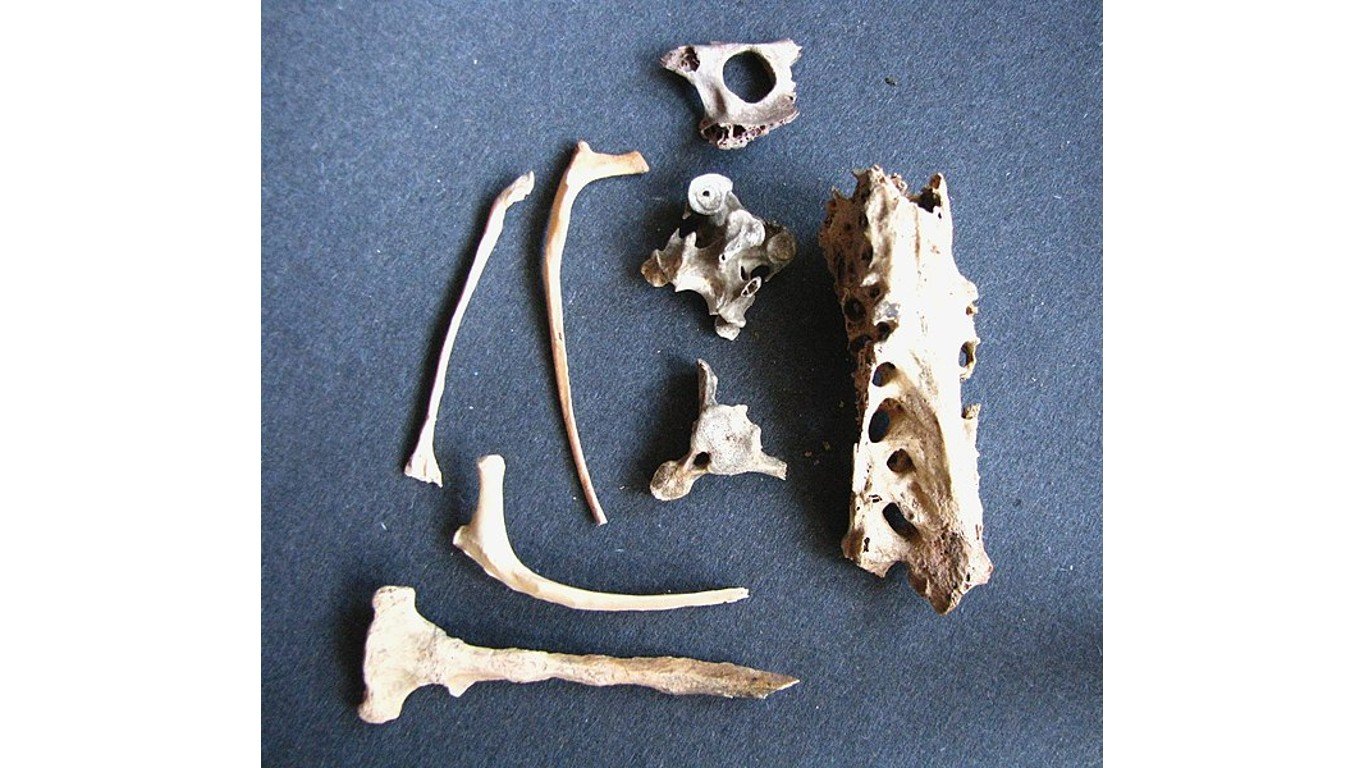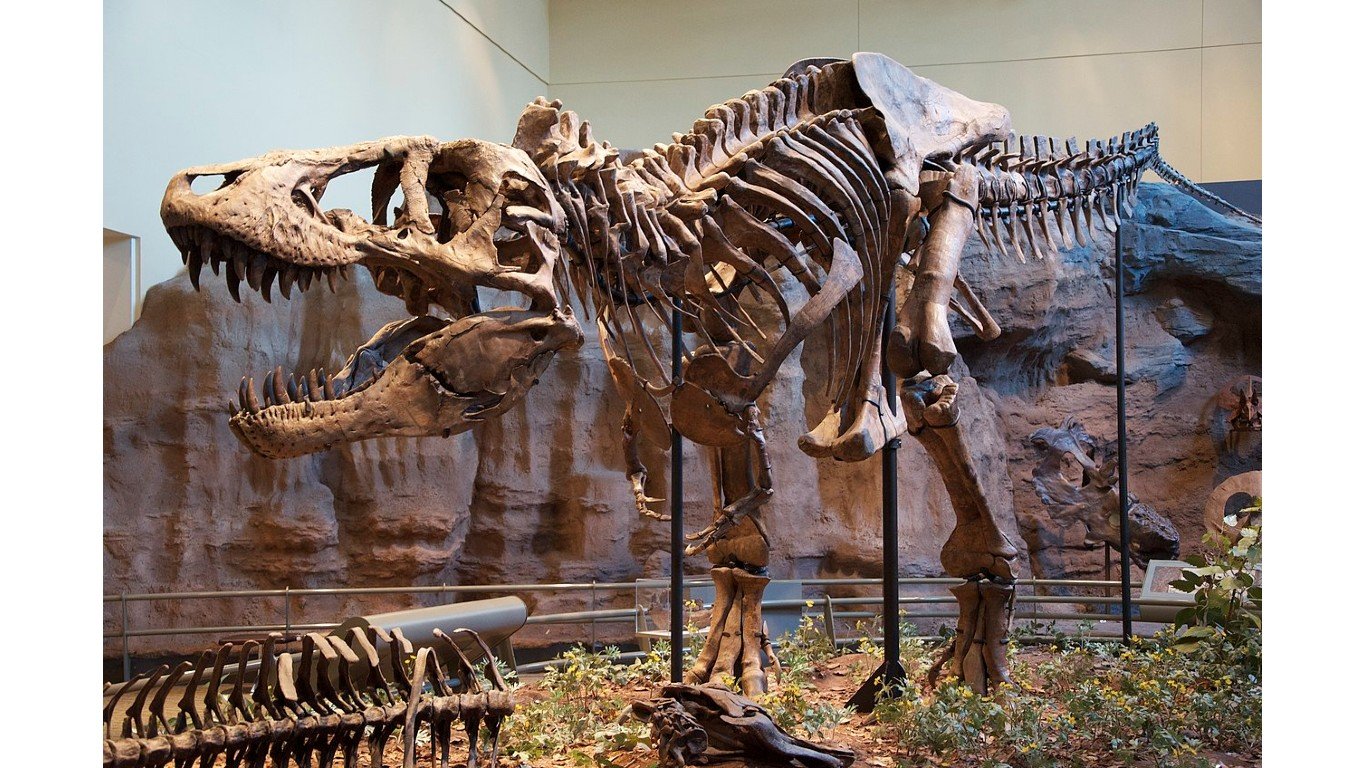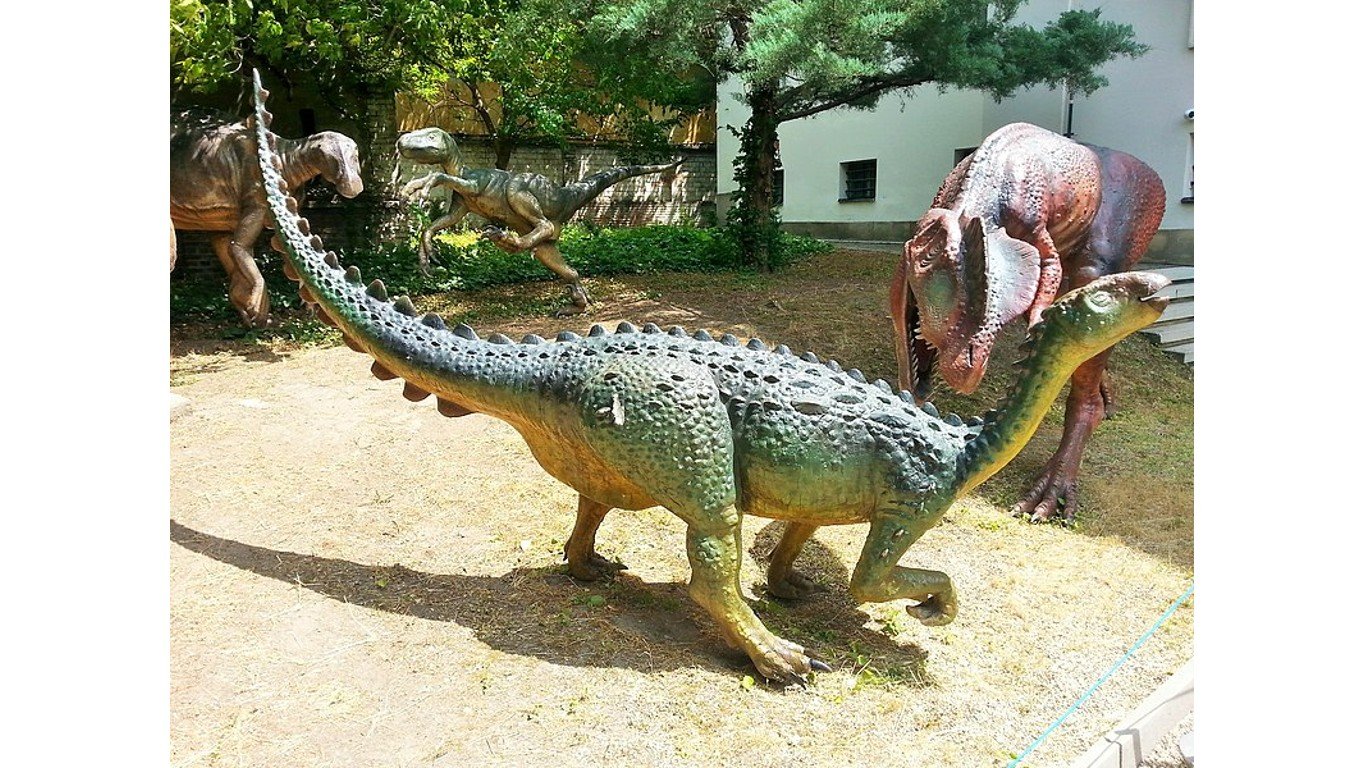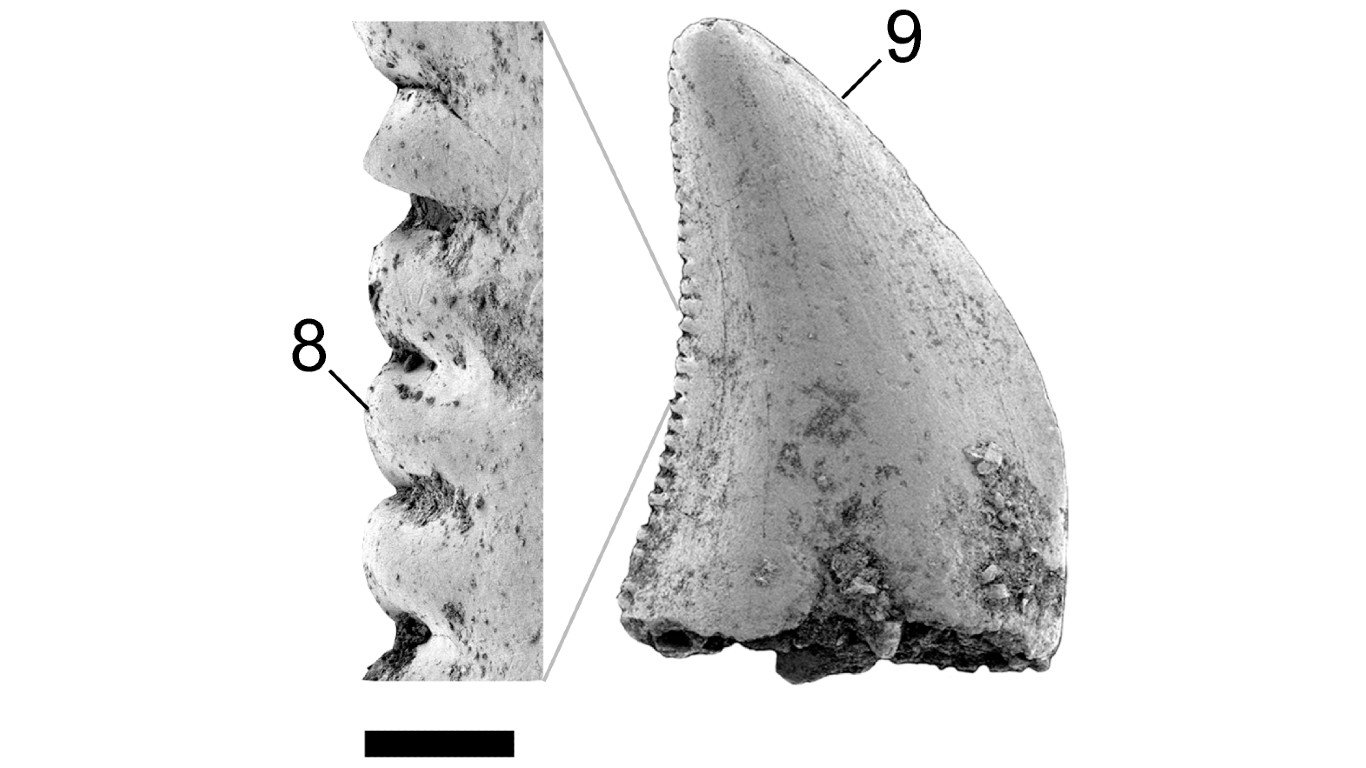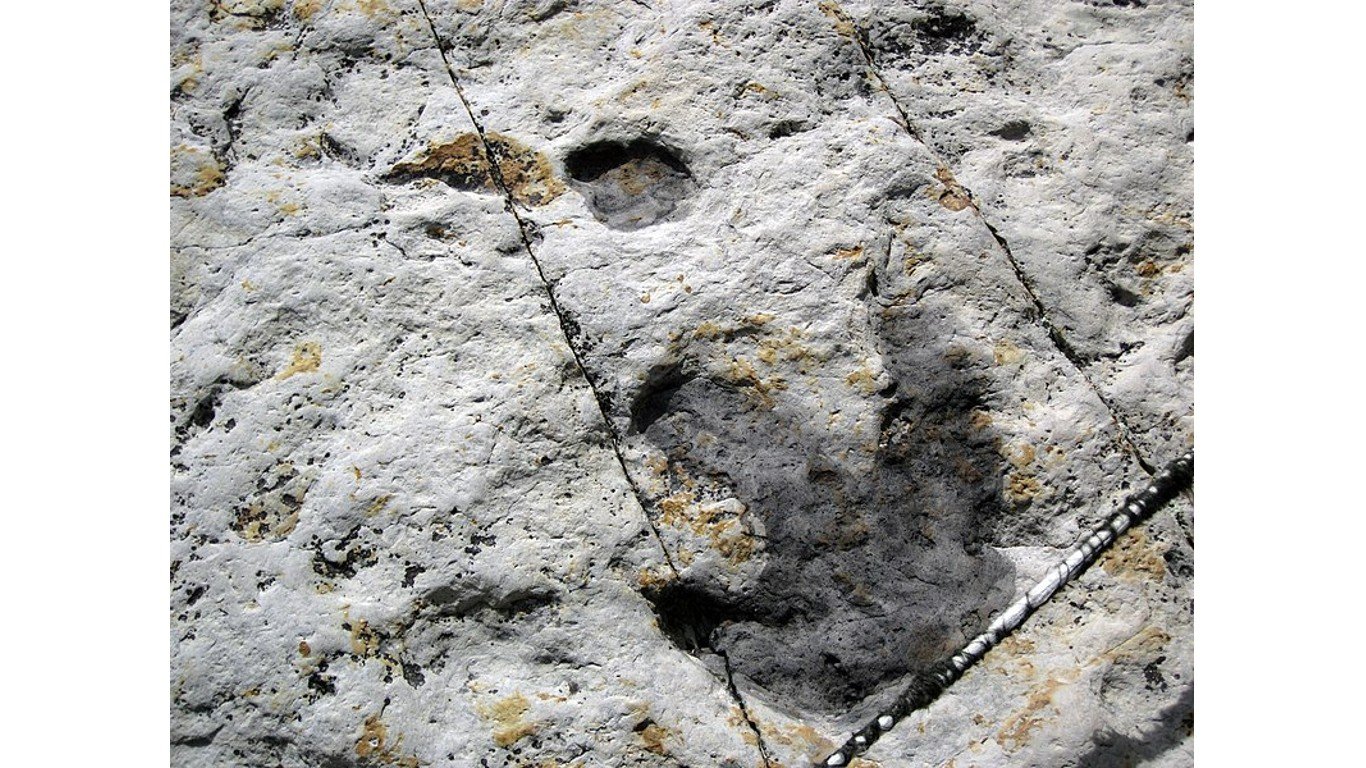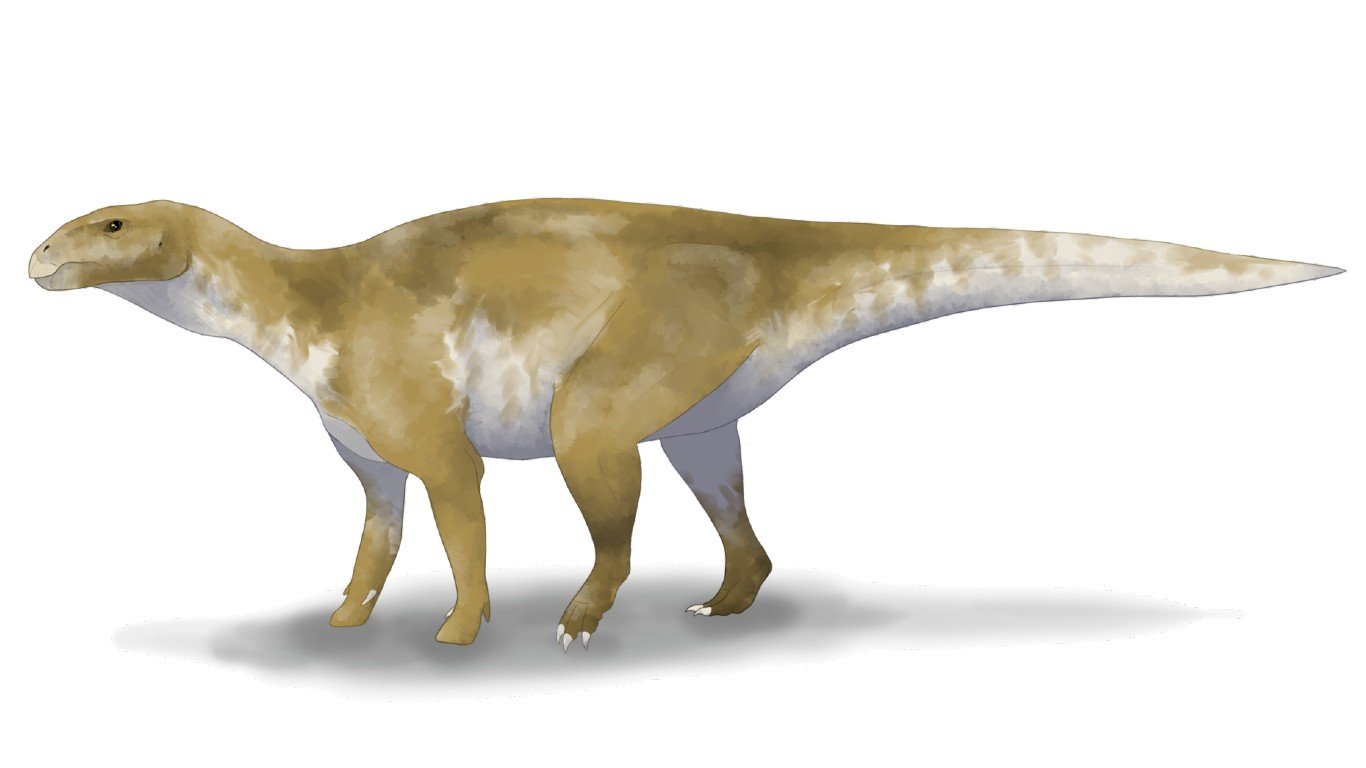In 1836, two Massachusetts residents found a series of three-toed tracks embedded in sandstone in the Connecticut River Valley. The president of Amherst College, Reverend Edward Hitchcock, described the tracks in the American Journal of Science as having been made by giant, three-toed birds. The footprints were, in fact, dinosaur footprints. (This is the largest dinosaur in history.)
Hitchcock’s article would go down in history as one of the first scientific descriptions of dinosaur fossils made in the United States. (Although they are not bodily remains or bones, dinosaur tracks are categorized as fossils in the field of modern paleontology.) Dinosaur fossils, including tracks, have been found in all but five states – Vermont, New Hampshire, Rhode Island, Wisconsin, and Kentucky.
To compile a list of the states with the most dinosaur fossils, 24/7 Tempo reviewed the Paleobiology Database, a public database of paleontological data maintained by paleontologists from around the world. Numbers do not reflect all dinosaur fossils in the U.S., but rather the fossils available in public collections. Most commonly found fossils are listed as species unless otherwise noted. Data is accurate as of September 2022.
When Reverend Hitchcock presumed that the prehistoric tracks were made by birds, he wasn’t far off. It is commonly accepted that modern birds can trace their ancestry back to a clade (an unranked taxon, or taxonomic group) of dinosaurs known as theropods, which had hollow bones, three toes, and clawed limbs. Tyrannosaurus and Velociraptor are some of the better-known theropods.
Birds are basically living dinosaurs, then, and some of the most common dinosaur bones found in the United States are prehistoric specimens of bird species that still exist today. Other prevalent fossil species in the U.S. include hadrosaurids, which were duck-billed herbivores, and ceratopsia, of which the Triceratops is the best-known. Many of these fossils are available to view in museums around the country. (These are the must-visit museums in every state.)

26. Georgia
> Total number of fossils found: 55
> Age from which most fossils found: Late Pleistocene (126,000 to 11,700 years ago)
> Number of fossils from the Late Pleistocene age found: 48
> Most commonly found species: Meleagris gallopavo (3)
Bird species like the wild turkey (Meleagris gallopavo), the Eurasian teal, and the wood duck make up the vast majority of fossils found in Georgia. However a few extinct bird species like the passenger pigeon have also been found there, as have a handful of older dinosaur bones from albertosaurus, hydrosaurus, and ornithomimidae, a family of theropods resembling ostriches.
25. Kansas
> Total number of fossils found: 57
> Ages from which most fossils found: Blancan and Late Coniacian (5 to 2 million years ago and 90 to 86 million years ago)
> Number of fossils from the Blancan and Late Coniacian ages found: 16 (8 each)
> Most commonly found species: Ichthyornis dispar, Parahesperornis alexi (3 each)
Ichthyornis, a dinosaur that resembled a sea bird, and parahespornis, a prehistoric flightless bird, represent the most prevalent fossils found in Kansas. Ichthyornis is one of the closest non-avian ancestors of modern birds, and the first known bird ancestor to have teeth.

24. Nebraska
> Total number of fossils found: 58
> Ages from which most fossils found: Clarendonian, Early Barstovian, and Hemingfordian (12 to 9 million years ago, 16 to 15 million years ago, and 21 to 16 million years ago)
> Number of fossils from the Clarendonian, Early Barstovian, and Hemingfordian ages found: 36 (12 each)
> Most commonly found species: Pediohierax ramenta (4)
An extinct species of primitive falcon, the Pediohierax ramenta, is the most commonly found fossil species in Nebraska. The birds lived 15 million years ago during the Miocene Period, and their bones have not been found anywhere else on earth.
23. Oklahoma
> Total number of fossils found: 59
> Age from which most fossils found: Late Kimmeridgian (157 to 152 million years ago)
> Number of fossils from the Late Kimmeridgian age found: 25
> Most commonly found species: Camarasaurus, Tenontosaurus genera (6 each)
In Oklahoma, the most common fossils come from the Camarasaurus (a long-necked, small-headed herbivore) and the Tenontosaurus (an herbivore with a long, thick tail). Of all the long-necked sauropods, Camarasaurus is the most commonly found in North America.
22. Alabama
> Total number of fossils found: 59
> Age from which most fossils found: Late Pleistocene (126,000 to 11,700 years ago)
> Number of fossils from the Late Pleistocene age found: 37
> Most commonly found species: Hadrosauridae family (6)
Of the few dozen dinosaur fossils found in Alabama, most are from a disparate variety of creatures. The most fossils from a single family are Hadrosauridae. These were found in five different counties in the state. Hadrosaurids were duck-billed herbivores that usually walked on four legs but were capable of walking on two.
21. Idaho
> Total number of fossils found: 72
> Age from which most fossils found: Late Albian (113 to 100 million years ago)
> Number of fossils from the Late Albian age found: 29
> Most commonly found species: Dromaeosauridae family (3)
Often referred to as raptors, Dromaeosauridae are a family of feathered running lizards that have been found across the earth, including in Idaho. They ranged from about two to 20 feet in length and had a sharp, enlarged claw on each foot.
20. Maryland
> Total number of fossils found: 73
> Age from which most fossils found: Late Aptian (125 to 113 million years ago)
> Number of fossils from the Late Aptian age found: 29
> Most commonly found species: Ornithomimosauria clade (6)
The clade of bird-mimicking lizards known as Ornithomimosauria have left multiple fossil deposits in Maryland. Similar to ostriches, these quick-moving creatures had feathers and were variously omnivorous or herbivorous. Multiple fossils belonging to the Ankylosauria, a clade of bulky, armored dinosaurs similar to tortoises, have also been found in the state.
19. Hawaii
> Total number of fossils found: 95
> Age from which most fossils found: Holocene (12,000 to 11,500 years ago)
> Number of fossils from the Holocene age found: 57
> Most commonly found species: Apteribis sp. (10)
The fossilized remains of small extinct ibises in the genus Apteribis have only been found on the Hawaiian islands of Molokai, Lanai, and Maui. The flightless birds likely lived on forest floors and ate snails.
18. Connecticut
> Total number of fossils found: 109
> Age from which most fossils found: Hettangian (201 to 199 million years ago)
> Number of fossils from the Hettangian age found: 105
> Most commonly found species: Grallator tuberosus (16)
Dinosaur State Park in Rocky Hill contains one of the largest dinosaur track sites in the U.S., with over 2,000 tracks including 500 in an enclosed exhibit. The most prevalent tracks are from Grallator and Eubrontes theropods.
17. Alaska
> Total number of fossils found: 109
> Age from which most fossils found: Holocene (12,000 to 11,500 years ago)
> Number of fossils from the Holocene age found: 52
> Most commonly found species: Aethia sp. (9)
Several species of Aethia – small seabirds known as auklets – are the most abundant species whose fossils have been found in Alaska. Another dinosaur found in the state is Dromaeosaurus albertensis, a medium sized bipedal carnivore that was much more heavily built than other typical theropods of its size, like the velociraptor.
16. New Jersey
> Total number of fossils found: 139
> Age from which most fossils found: Norian (227 to 209 million years ago)
> Number of fossils from the Norian age found: 26
> Most commonly found species: Grallator sp. (24)
Footprints, including those categorized as Grallator prints (three-toed prints made by small bipedal theropods), are the most prevalent dinosaur fossil species found in New Jersey. Hadrosaurid (duck-billed dinosaur) fossils are also common in the state. The first nearly-intact dinosaur skeleton ever found in North America was a Hadrosaurus foulkii discovered in New Jersey in the 19th century.

15. North Carolina
> Total number of fossils found: 151
> Age from which most fossils found: Zanclean (5.3 to 3.6 million years ago)
> Number of fossils from the Zanclean age found: 106
> Most commonly found species: Morus sp. (8)
Several extinct species of gannet (Morus sp.), a seabird related to the booby, have been found in Beaufort County, North Carolina. In the coastal plains surrounding the Pamlico River, Beaufort is known for its fossil riches, especially large shark teeth.
14. Oregon
> Total number of fossils found: 156
> Age from which most fossils found: Late Pleistocene (126,000 to 11,700 years ago)
> Number of fossils from the Late Pleistocene age found: 120
> Most commonly found species: Eremochen russelli (3)
The Eremochen (which means “desert goose”) russelli is an extinct species of water bird that likely resembled a smaller version of the Canada goose. Its fossilized remains in Oregon are holotypic, which means that they are the only example of its species ever found.
13. South Dakota
> Total number of fossils found: 199
> Age from which most fossils found: Late Maastrichtian (72 to 66 million years ago)
> Number of fossils from the Late Maastrichtian age found: 94
> Most commonly found species: Tyrannosaurus rex (6)
While the most commonly identified species of dinosaur fossil in South Dakota is Tyrannosaurus rex, of the genus Tyrannosaurus. An even more common genus found in the state is Triceratops, whose species were a main food source for Tyrannosaurs.
12. Arizona
> Total number of fossils found: 224
> Age from which most fossils found: Sinemurian (199 to 191 million years ago)
> Number of fossils from the Sinemurian age found: 59
> Most commonly found species: Scutellosaurus lawleri (17)
An armored, herbivorous dinosaur, Scutellosaurus lawleri had several hundred bony plates running down its back and tail. The species has only ever been found in Coconino County, Arizona, where a single partial skeleton was discovered on Navajo land.
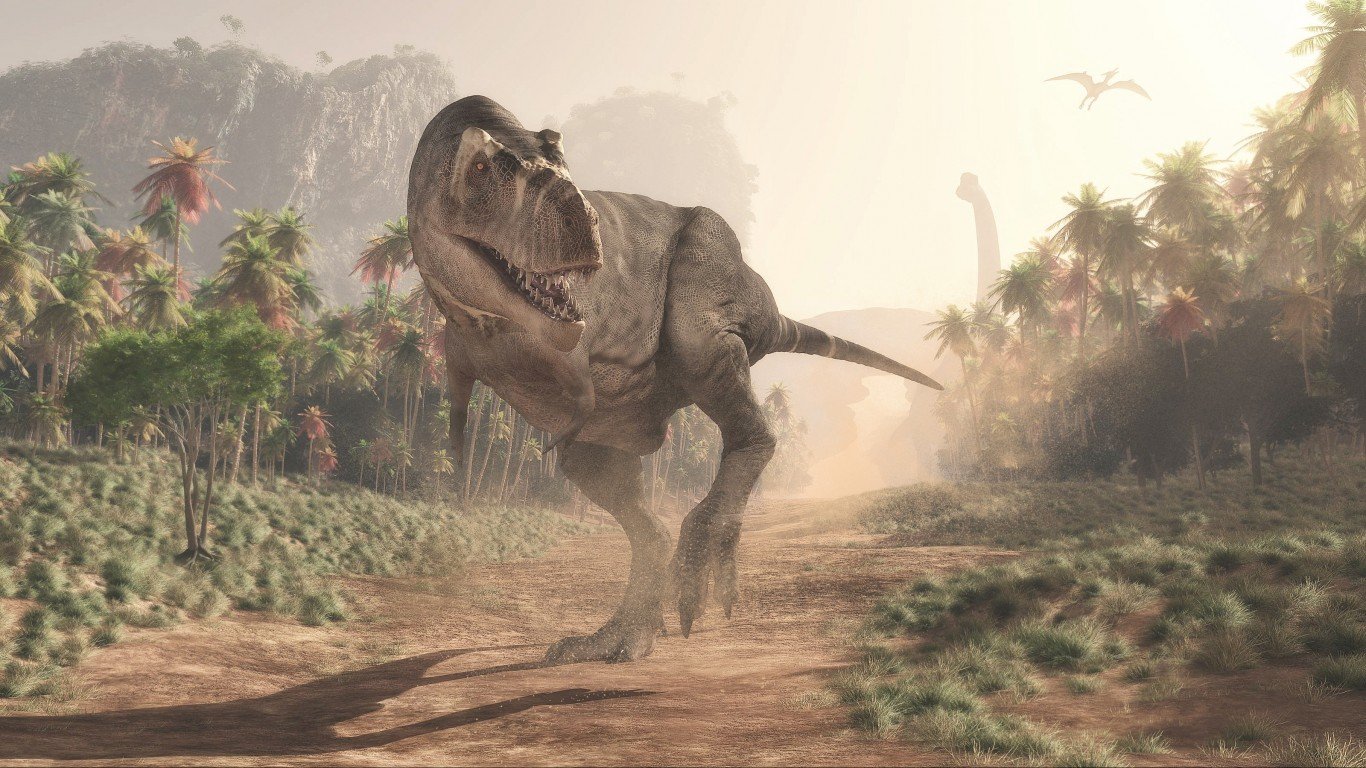
11. North Dakota
> Total number of fossils found: 251
> Age from which most fossils found: Late Maastrichtian (72 to 66 million years ago)
> Number of fossils from the Late Maastrichtian age found: 138
> Most commonly found species: Tyrannosaurus rex (22)
Of all the fossil species identified in North Dakota, Tyrannosaurus rex is the most prevalent species. These large carnivorous theropods ranged through western North America. In 2021, rare juvenile T-rex bones were excavated on private land in a remote area of the state.

10. Virginia
> Total number of fossils found: 280
> Age from which most fossils found: Late Pleistocene (126,000 to 11,700 years ago)
> Number of fossils from the Late Pleistocene age found: 177
> Most commonly found species: Miocepphus mcclungi (8)
Most of the dinosaur fossils found in Virginia have belonged to prehistoric birds, such as the Miocepphus mcclungi, a small extinct species of auk, as well as extant birds like the wild turkey and the great horned owl. Dinosaur footprints have also been discovered in the state, along with prehistoric whale, shark, and mastodon bones.
9. Massachusetts
> Total number of fossils found: 319
> Age from which most fossils found: Hettangian (201 to 199 million years ago)
> Number of fossils from the Hettangian age found: 310
> Most commonly found species: Anomoepus scambus (45)
Dinosaur tracks are the official Massachusetts state fossil, and the most common species of fossil found are Anomoepus scambus footprints. The Connecticut River Valley is a rich area for fossil footprints, and South Hadley is considered the location of the first dinosaur tracks ever found in the United States.
8. Texas
> Total number of fossils found: 496
> Age from which most fossils found: Middle Campanian (83.6 to 72.1 million years ago)
> Number of fossils from the Middle Campanian age found: 128
> Most commonly found species: Richardoestesia gilmorei (12)
Richardoestesia gilmorei, the most common species of fossils found in Texas, represent the teeth of a species of theropod with long slender jaws. The finely serrated teeth are distinctive to the species. Pachycephalosauria (bipedal omnivores with thick, domed skulls) and Tyrannosaurid fossils are also common in the state.
7. Colorado
> Total number of fossils found: 583
> Age from which most fossils found: Kimmeridgian (157 to 152 million years ago)
> Number of fossils from the Kimmeridgian age found: 150
> Most commonly found species: Hadrosauropodus leonardii (12)
A common species that left fossils in Colorado is the Hadrosauropodus leonardii, which has been identified not by bones, but by fossilized footprints. These footprints are classified as Cararichnium, which is an ichnogenus – a taxon (taxonomic group) based on the fossilized traces left behind by an organism, rather than its bones.
6. Utah
> Total number of fossils found: 776
> Age from which most fossils found: Pliensbachian (190 to 183 million years ago)
> Number of fossils from the Pliensbachian age found: 78
> Most commonly found species: Eolambia caroljonesa (12)
While unclassified theropod (a clade of hollow-boned, three-toed, clawed dinosaur) fossils are commonly found in Utah, the most common species identified is the Eolambia caroljonesa, an herbivorous duck-billed dinosaur that hasn’t been found anywhere else on the planet. Long-necked brachiosauridae have also been found in the state, as have a huge array of fossilized footprints.
5. Florida
> Total number of fossils found: 894
> Age from which most fossils found: Late Pleistocene (126,000 to 11,700 years ago)
> Number of fossils from the Late Pleistocene age found: 393
> Most commonly found species: Podilymbus podiceps (24)
Although extant birds – such as the pied-billed grebe, the most commonly found fossil species in the state – make up the majority of prehistoric dinosaur fossils found in Florida, a few extinct species have also been found there, including Waller’s terror bird, a flightless carnivore that stood up to six feet tall.
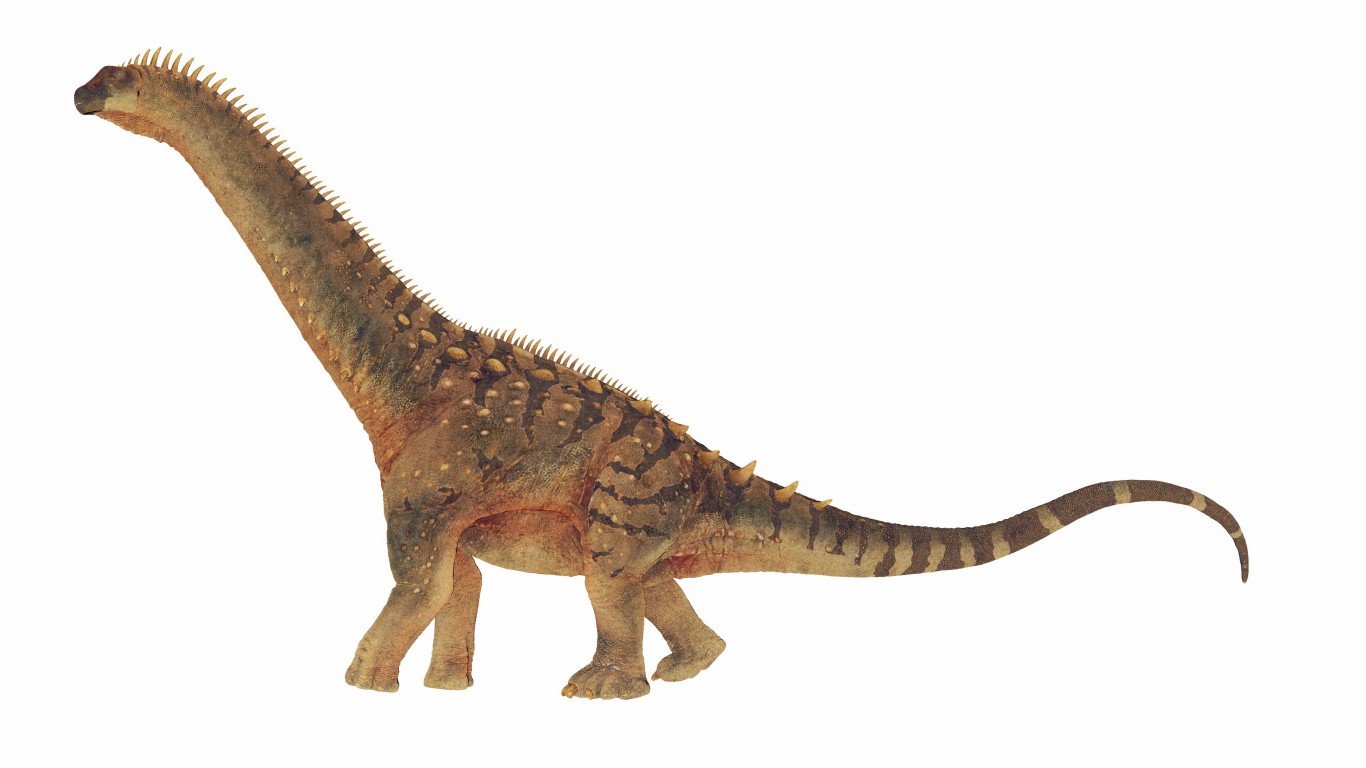
4. New Mexico
> Total number of fossils found: 935
> Age from which most fossils found: Late Campanian (76 to 74 million years ago)
> Number of fossils from the Late Campanian age found: 555
> Most commonly found species: Alamosaurus sanjuanensis (20)
Over 200 fossils from the Hadrosauridae family, also known as duck-billed dinosaurs, have been found in New Mexico, as well as over 80 fossils of Ceratopsia, a clade of horned herbivorous dinosaurs that includes the Triceratops. Alamosaurus, the most common species found in the state, is the largest known dinosaur found in North America.
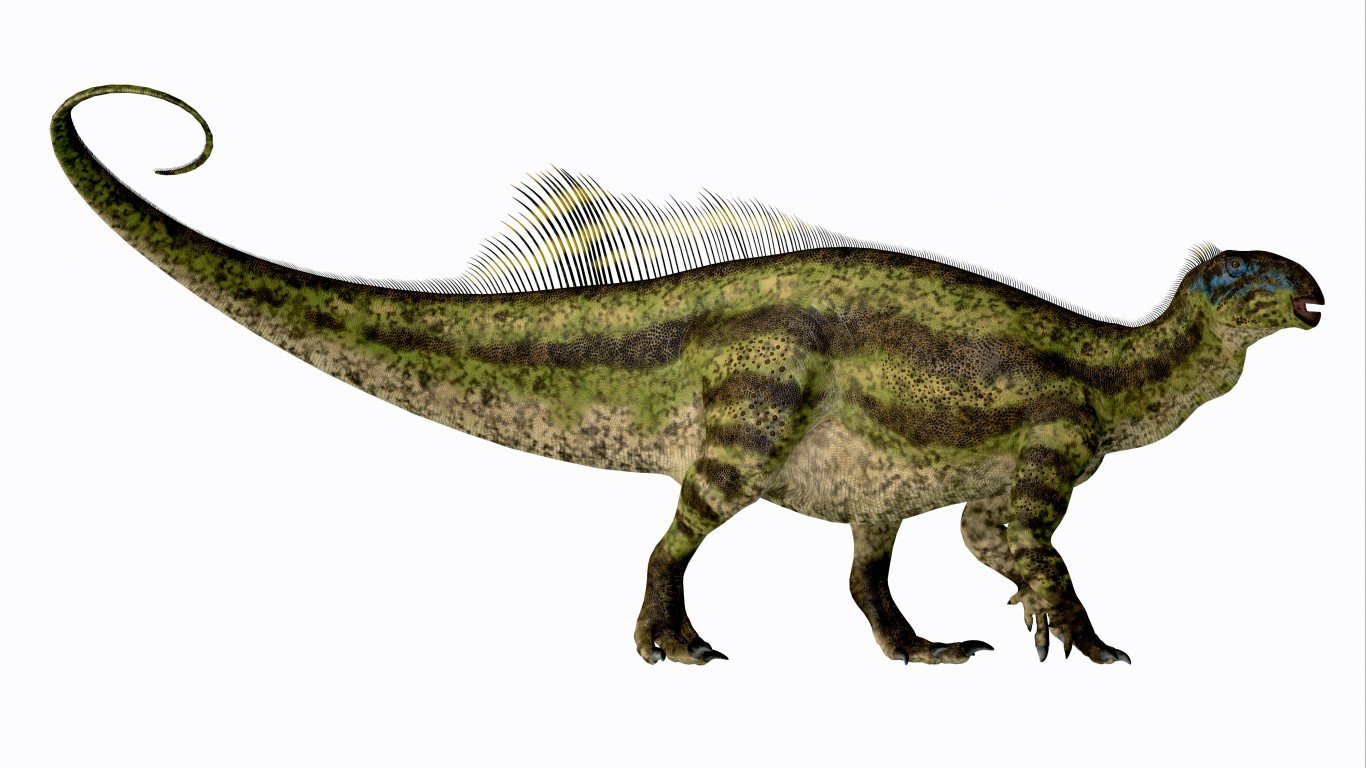
3. Montana
> Total number of fossils found: 939
> Age from which most fossils found: Lancian (71 to 66 million years ago)
> Number of fossils from the Lancian age found: 246
> Most commonly found species: Tenontosaurus tilletti (45)
Over 80 different species of dinosaur fossils have been identified in Montana – more than in any other state. The most common species is Tenontosaurus tilletii (a bipedal herbivore), the first fossils of which were found in Montana in 1903.
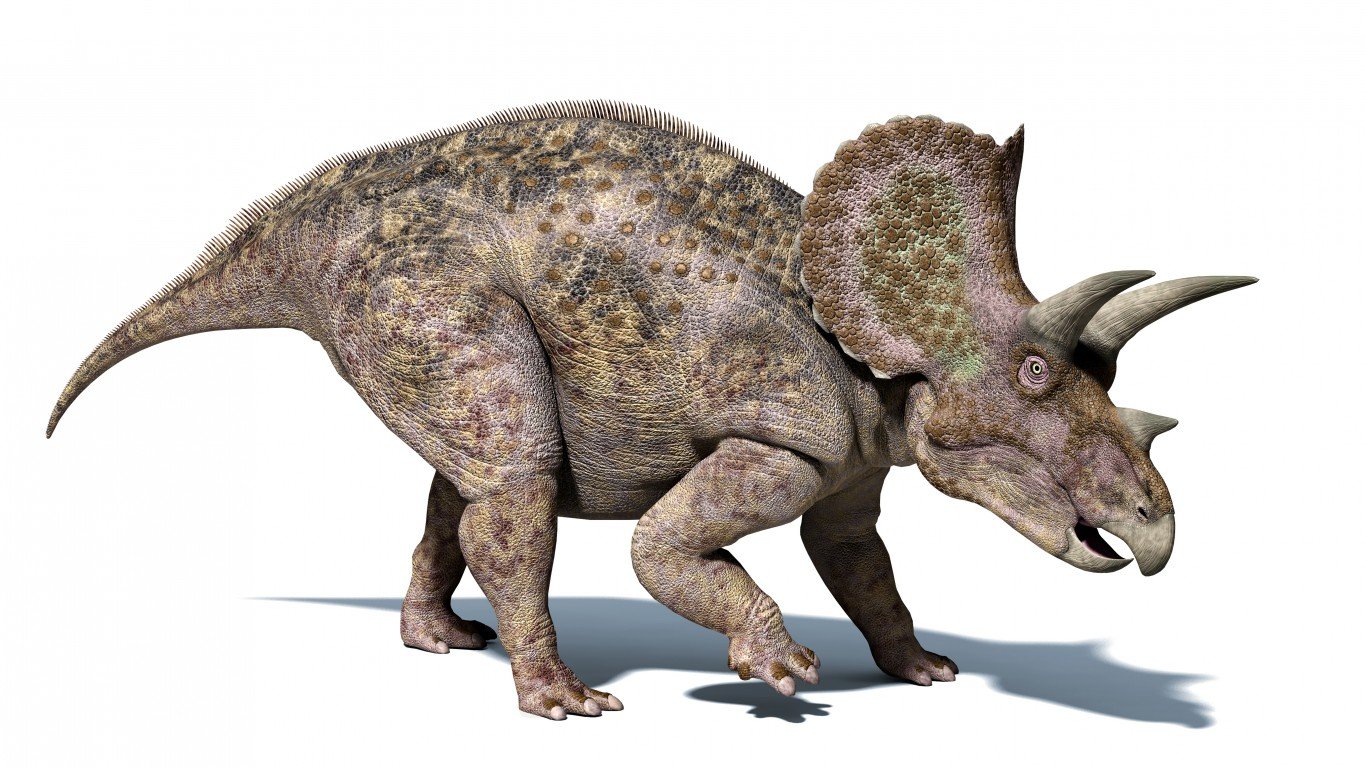
2. Wyoming
> Total number of fossils found: 1,135
> Age from which most fossils found: Kimmeridgian (157 to 152 million years ago)
> Number of fossils from the Kimmeridgian age found: 360
> Most commonly found species: Triceratops horridus (26)
Wyoming is one of the most productive fossil sites in the world. Several well-known genera of dinosaurs have been found in the state’s massive fossil deposits, including Stegosaurus, Allosaurus, Triceratops, and Tyrannosaurus.

1. California
> Total number of fossils found: 1,992
> Age from which most fossils found: Late Pleistocene (126,000 to 11,700 years ago)
> Number of fossils from the Late Pleistocene age found: 751
> Most commonly found species: Branta canadensis (29)
Most of the dinosaur fossils found in California are actually those of birds, especially ancient water birds like ducks, grebes, cormorants, puffins, and geese – some of which still exist today, including mallards and Canada geese.
